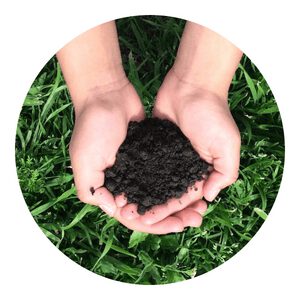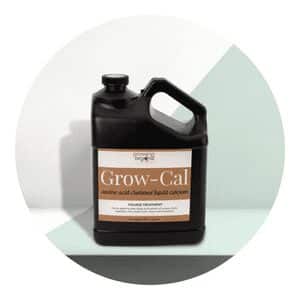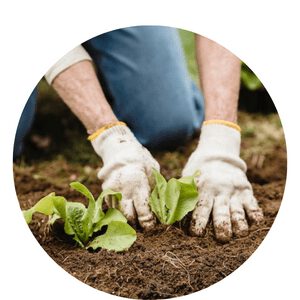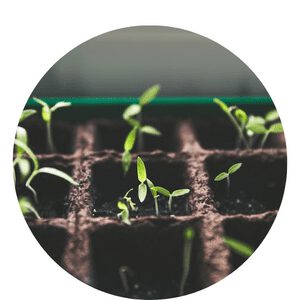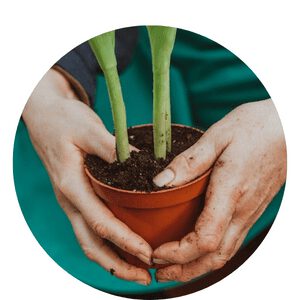Natural Landscaping
Organic gardening is a great way to create a natural, sustainable and healthy outdoor environment.
Natural landscaping is one of the most important aspects of organic gardening and it can be achieved in various ways.
By using natural materials and plants, as well as other techniques such as mulching and composting, you can create a beautiful space that is both pleasing to look at and beneficial for the environment.

Natural Landscaping Menu
Definition of natural landscaping
Natural landscaping is a term used to define an organic gardening style that utilizes natural elements to create an aesthetically pleasing environment, with minimal interference from humans.
It takes advantage of existing native plants and trees, as well as utilizing other natural resources like stones, sand, mulch and even water.
This form of gardening allows nature to take its course without human intervention.
Natural landscaping encourages the growth of wildflowers, shrubs and trees in order to attract beneficial wildlife such as birds and butterflies.
This type of gardening does not require any chemicals or fertilizers; instead it uses composting methods for soil improvement which helps reduce both water consumption and waste disposal.
It also reduces the need for controlling weeds by creating thick ground cover plants which prevent them from taking over the garden space.
Benefits of natural landscaping
Using natural landscaping in organic gardening is a great way to boost the overall health of your garden.
Natural landscaping helps to preserve the environment by reducing water and energy consumption, improving soil fertility and promoting biodiversity.
It also allows you to enjoy a beautiful landscape without having to use chemicals or other synthetic materials that are potentially hazardous for humans, animals and plants.
In addition to preserving the environment, natural landscaping can provide numerous benefits for the garden itself.
By using native plants such as shrubs and trees, you will be able to reduce water needs since these plants are adapted to local climates.
Additionally, native species tend not require extra fertilizers or pesticides because they are naturally resistant to pests.
Furthermore, using native plants can help attract beneficial insects such as pollinators which will help promote plant growth and improve yields in fruits and vegetables.
Principles of Natural Landscaping
Natural landscaping, or eco-friendly gardening, is an increasingly popular approach to gardening that focuses on creating lush, vibrant outdoor spaces with minimal environmental impact.
It emphasizes natural processes as much as possible and uses sustainable materials and methods.
The following are some of the core principles of natural landscaping:
The first principle is to respect nature by minimizing disruption to existing ecosystems, such as trees and wildlife habitats.
This can be done by using native plants whenever possible and avoiding invasive species, which can disrupt the local ecology.
Natural landscaping also encourages the use of organic mulch and compost instead of chemical fertilizers; this conserves resources while helping to protect local water systems from runoff from synthetic chemicals.
Using native plants
Native plants are particularly well-suited to organic gardening as these species have already adapted to the local environment, making them hardier and less likely to require artificial interventions.
As such, incorporating native plants into your landscaping has numerous benefits to both gardeners and the environment at large.
By using native plants in your garden, you can create a richly diverse habitat that provides food, shelter, and breeding grounds for wildlife.
Additionally, native species are more resistant to pests and diseases than non-native varieties due to their adaptation over time to their particular region’s climate conditions.
This makes them easier and less expensive to maintain since they don’t require as much fertilizer or irrigation as non-native plants do.
Organic Garden guides, sure to please, Making sure that nature has to increase. Natural landscaping is the way, With such concepts thy can no longer stay away. Gardening with a conscience, so strong and true, Ensuring us that nature’s beauty shines through. The approach of organic gardening is wise, And connecting with nature in this new guise. From now on natural landscapes will bloom, For it's always been our Nation’s best destination room!
Chappy The Gardener
Minimizing the use of chemicals and synthetic materials
Organic gardening is a growing trend, and for good reason.
By utilizing natural landscaping techniques, one can create a beautiful outdoor space without resorting to the use of chemicals or synthetic materials.
Natural landscaping reduces environmental stress and requires fewer resources than many conventional methods, making it an ideal option for green-minded gardeners.
Natural landscaping chiefly involves the use of plants native to your region in order to reduce the need for supplemental irrigation or fertilizers.
It also means avoiding the use of toxic chemicals such as pesticides or herbicides that can be harmful not just to pests, but to beneficial insects and wildlife as well.
Instead, organic gardeners focus on creating healthy soil with composting and mulching, which helps keep weeds away without relying on dangerous substances.
Protecting and preserving natural habitats
Protecting and preserving natural habitats is a critically important task for us all.
Our planet’s ecosystems provide essential resources that are necessary to sustain life on Earth, from fresh air and clean water to food sources of all types.
Natural landscaping in organic gardening combines the beauty of nature with sustainable practices, making it an excellent way to contribute to this essential effort.
Organic gardening is a form of horticulture that focuses on cultivating plants without the use of synthetic pesticides, herbicides or fertilizers.
By planting native species or those most suited for your home’s environment, you can help create and maintain healthy habitats where wildlife can thrive.
Natural landscaping also encourages beneficial insects like bees that pollinate plants while keeping noxious pests at bay.
Creating a sustainable ecosystem
Creating a sustainable ecosystem is an important concept in organic gardening.
It involves finding ways to maintain and preserve the environment, while still maintaining a healthy garden full of plants, flowers, and trees.
Natural landscaping helps create a sustainable ecosystem by using natural resources such as rocks, wood chips or mulch, and native plants to help reduce erosion and runoff.
Additionally, it helps conserve water by selecting drought-tolerant plants that require minimal watering.
Organic gardening plays an essential role in helping to build a sustainable ecosystem.
By avoiding synthetic fertilizers or pesticides that can contaminate soils and pollute waterways, one is creating an environment more conducive to the health of both their garden and the surrounding areas.
Organic gardening also encourages biodiversity by planting native plants that provide food for beneficial insects like bees and butterflies which are essential for pollinating other plant species.
Designing a Natural Landscape
Designing a Natural Landscape is an important aspect of organic gardening.
Natural landscaping involves creating a garden environment that mimics the natural conditions of the local area.
It not only looks beautiful, but it can also help promote healthy and diverse plant life within your garden.
To accomplish this, it’s essential to consider the climate, soil type, and existing plants in your area when planning out your landscape design.
When designing a natural landscape for an organic garden, think about how to create a space that is self-sufficient and requires minimal maintenance.
Consider planting native species that thrive in your region such as trees, shrubs, flowering plants or grasses.
Incorporating elements like water features or rock gardens can add texture and interest while still retaining the natural look.
Additionally, you should incorporate plants with different heights and shapes to provide visual variety throughout the year.
Choosing the right plants and materials
Organic gardening is a hobby that many Green Thumbs have adopted over the years.
But how do you create a natural landscape without compromising your organic gardening principles?
It all starts with making smart choices when choosing plants and materials for your garden.
The first step in creating an organic garden and landscape is to carefully select the plants, flowers, and shrubs you want to use.
Many of these plants are available in both traditional nurseries as well as organic-certified ones, so make sure you read up on the plant’s needs before purchasing it.
Additionally, use native species whenever possible as they are generally more resistant to pests and disease.
In addition to selecting healthy plants, consider adding mulch or compost which will help retain moisture in the soil while keeping weeds out.
Creating a balanced and harmonious design
Creating a balanced and harmonious design is an essential part of organic landscaping.
The goal of this type of gardening is to create a living space that blends with nature while providing beauty and enjoyment.
Achieving this balance requires careful consideration when selecting plants, flowers, and trees that are in harmony with the local climate and environment.
Organic gardeners should take into account the growing conditions, such as soil type, light levels, water availability, when choosing plants.
Once the right selection is made for each area of the garden, it’s important to pay attention to aesthetics.
Layering plants can add depth to your landscape or selecting a mix of colors can bring attention to specific areas or focal points.
It’s also important to keep scale in mind when placing objects like benches or sculptures throughout your property so that everything looks harmonious and complementary with one another.
Incorporating elements such as water features and wildlife habitats
Organic gardening is growing in popularity, and many gardeners are now looking to incorporate a variety of elements into their gardens.
Natural landscaping can offer a great way to create an aesthetically pleasing outdoor space that also benefits the environment.
Incorporating elements such as water features and wildlife habitats is one way to add beauty and functionality to your backyard.
Water features, like ponds or waterfalls, bring visual interest and sound to your outdoor space while also providing habitat for fish and aquatic plants.
When building these features, consider using natural materials such as stones or logs instead of plastic liners or manufactured products.
Additionally, planting native species around the feature will provide food sources for local wildlife.
Wildlife habitats are another key component of natural landscaping; they provide shelter for birds, butterflies, small mammals, and other creatures in our backyards.
Maintenance and Care of a Natural Landscape
When it comes to organic gardening, natural landscaping is an important part of creating a sustainable environment.
Maintenance and care of a natural landscape is essential in order to keep it looking its best and promoting healthy growth within the garden.
The following are some tips for maintaining and caring for a natural landscape.
The most important aspect of maintenance is keeping the area free from weeds that can crowd out desirable plants in the garden.
This can be done through manual or mechanical removal, or by using certain types of herbicides or mulches that prevent weed growth.
It is also important to keep up with regular pruning and trimming of trees, shrubs, and other plants in order to ensure they remain healthy and attractive.
In addition, adding organic matter such as compost can help improve soil quality as well as providing nutrients for your plants.
Techniques for maintaining a natural landscape
Maintaining a natural landscape is one of the most important steps in organic gardening.
It promotes biodiversity, reduces soil erosion and provides an aesthetically pleasing environment for both humans and other forms of life.
Natural landscaping involves creating a sustainable ecosystem that requires little to no additional inputs from the gardener.
Here are some techniques for maintaining a natural landscape:
First, it’s important to select native plants that can thrive in your local climate and will require minimal maintenance once established.
Additionally, planting in groupings of three or more can help promote biodiversity as each species will benefit from the different microclimates created by the others in its group.
Furthermore, adding grasses and ground covers can help keep weeds at bay while also providing food sources and habitat for beneficial insects like bees and butterflies.
Tips for preserving the natural beauty of the landscape
Preserving the natural beauty of the landscape is important for every gardener.
Natural landscaping is a great way to create a garden that blends with the natural environment and enhances its beauty.
Organic gardening techniques can be used to create an aesthetically pleasing garden while maintaining ecological balance in your outdoor space.
Here are some tips for preserving the natural beauty of your outdoor area through organic gardening:
Start by researching native plants and animals in your area, and incorporate them into your design.
Native plants are adapted to local conditions, require less maintenance, and provide food sources for wildlife.
When planting trees, shrubs, flowers, and grasses try to match their original habitat as closely as possible.
Additionally, select plants that have a low water requirement so they consume less resources while still providing visual interest.
Strategies for dealing with pests and diseases
Organic gardening is a popular choice for many gardeners, but dealing with pests and diseases can be a challenge.
Fortunately, there are strategies that can help you keep your garden healthy and pest-free while still adhering to the principles of organic landscaping.
By understanding the lifecycle of common pests and diseases, you can stay one step ahead in managing them without resorting to chemical treatments.
First, it is important to practice preventive measures like rotation of crops, good sanitation habits, and using natural repellents like garlic or hot pepper spray.
Secondly, early detection of disease or infestation is essential; regular monitoring will enable you to take corrective action before the problem gets out of control.
Finally, if all else fails, it may be necessary to use physical removal methods such as handpicking insects off plants or pruning away infected parts of plants.
How to choose the right plants
Creating a natural landscape in an organic garden is a great way to add beauty and bring wildlife into the mix.
To do this, it’s important to choose the right plants for the job.
The following are some tips on how to select plants that will create an outstanding natural landscape without compromising your organic gardening practices.
When choosing plants, try to stick with native species that are well adapted to your climate and soil conditions.
Native species will require less maintenance as they are used to growing in these conditions naturally, so you won’t have spend extra time or money caring for them.
Additionally, they attract beneficial insects while discouraging pests and weeds from taking over the garden.
For example, using native herbs like oregano and lavender can help keep away certain insects while providing lovely aromas when brushed against or stepped on.
How to create a natural landscape on a budget
Creating a natural landscape in your garden can be an expensive endeavor, but there are ways to keep the costs down.
The first tip is to think outside of the box when it comes to materials. Reuse old furniture or upcycle items like pallets into unique garden features.
You can also look for used building materials at local stores or online marketplaces.
Additionally, buying plants in bulk is cheaper than purchasing them individually, and you can often find seedlings that are much less expensive than full-grown plants.
Finally, consider DIYing certain aspects of your natural landscape design.
How to maintain a natural landscape over time
Maintaining a natural landscape can be a daunting task, but with the right information it can be achieved.
Natural landscaping is a popular choice for organic gardeners as it involves utilizing native plants and other sustainable solutions to create an aesthetically pleasing garden.
There are several steps that need to be taken in order to ensure your natural landscape remains beautiful over time.
The first step is to perform soil analysis in order to determine which plants will thrive best in your particular environment.
This will help you decide which native species and other appropriate plants are suitable for your garden.
Additionally, proper watering techniques should be used based on the type of soil, climate and plant variety present in the area.
It is also important to periodically remove weeds by hand or with weed control products that are safe for use around native plants.
In conclusion, natural landscaping is a great way to bring beauty and diversity to your garden.
It’s important to research and understand the type of plants that are best suited for your specific climate, soil conditions and goals.
An organic approach to gardening can help you create a healthy outdoor living space that will provide enjoyment for years to come.
Through this method of gardening, you can reduce water use, conserve energy, protect biodiversity, and make the most of your outdoor space.
Click To Grow
Helps Us Grow – Share If You Like










